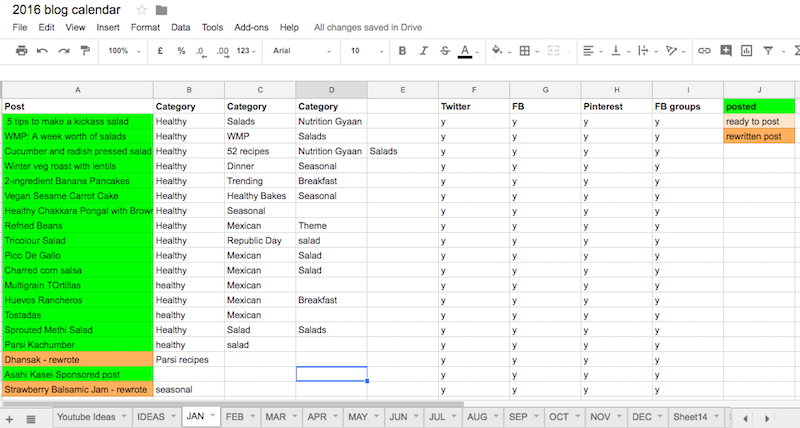
Editorial calendar for your food blog – one of the important tools for blogging success

What is an editorial calendar for blogging?
A content calendar / editorial calendar / blog calendar, they all mean the same thing. It is a plan for all the content that you will put out on your blog in the coming year.
Creating a rough editorial calendar for the whole year and a more detailed one for the next 2-3 months keeps you on top of the content you want to post on your blog.
Why have a content calendar for your blog?
Most magazines and websites work around an annual editorial calendar. It helps them plan ahead, commission the stories, sell advertising space etc. If you are a freelance writer, these calendars, usually available on their website or provided on request, help you pitch stories accordingly.
Your blog is like a magazine and you are its editor.
So why treat it any differently?
1. All the time and effort that goes into creating a blog post should be worth it. Choosing topics / recipes that will bring in the maximum audience makes all your effort worthwhile. Spending that extra bit of time doing research on what topics to write on is a very important part of blogging.
2. A blog editorial calendar amps up your productivity. Even if you write for your own blog, a calendar is a deadline that keeps you on track. Given that (in most cases) a blogger has no one to answer to but herself/ himself, we do tend to slack off at times, blogging at our whim and fancy. There’s no harm in that, but there’s one thing that is common to all successful bloggers. Consistency.
3. A content calendar helps you stick to your niche. For example, my niche is healthy vegetarian cooking. When I give my prepared content calendar a once over, if I notice too many deep fried / refined / sugar laden recipes, then I know I am not sticking to the promise to my audience. I can make the changes to my calendar and replace some of the posts that do not stick to my niche, with those that do. It saves a lot of time working on posts that do not add value to my reader.
4. It helps time your blog posts for the big trends (tentpole events) such as festivals, holidays and seasons. For example, in October, the entire US goes crazy searching for pumpkin recipes, so it is a good idea to post more pumpkin recipes to your blog in August and September. See what I mean by in time? When you pin these posts to Pinterest, it takes around one month for enough pin circulation to drive traffic to your blog when the searches peak. If you are a decor blogger, then November is a good time to write about Christmas decor hacks. Get my point?
5. A content calendar is very useful if you have a team that contributes towards writing, photography and social media. A shared calendar or Google sheet helps keep everyone in the loop.
6. Last but not the least, it helps you stay organised. Blogging is often a one-(wo)man-show. In case of a recipe blog, shopping, cooking, photographing, writing, editing and social media can often get way too overwhelming. A calendar helps you plan out each of these activities better. For example if there are three recipes in the coming month with similar ingredients, I would rather shop, cook and photograph them in a bunch to save time and effort. If you are a travel blogger and your August theme is weekend getaways, then you have Jan-July to do plan and go on a few weekend trips to add to your content in August.
A blog calendar is not set in stone.
Even if you plan well in advance, always keep room for changes. You may want to modify the existing calendar to suit current trends. A calendar can also be tweaked in response to audience behaviour. Say a cauliflower recipe gets 5x the number of views a new post usually gets on your blog, you can plan for more such recipes in the coming months.
What tools can you use for the blog editorial calendar?
You can use a regular planner /notebook for this purpose, a Google sheet, excel or one of the specialised editorial planning services like CoSchedule. Check out my sample Google Sheet below.
In one page / sheet, chart out the 12 months of the year and write down broad themes for each month. Themes are the categories you want majority of your posts to fit in. This annual calendar is a bird’s eye view of all the content you are going to write this year.
If you are a travel blogger, you can highlight a destination each month or a type of travel, say weekend trips or luxury holidays. For a food blogger, the overarching theme each month could be a seasonal ingredient, or a festival (Valentine’s / Diwali) or a cuisine. You could even have two themes for the month if you are aiming at 8-10 posts and not all posts need to stick to this theme. If a print magazine has a wedding special, then it usually carries some 7-8 stories around this theme but there will be lots of other content too. You could do the same on your blog.
How to figure out the best topics to blog about?
I have three ideas for you on how to figure out the best themes for the year.
- Conduct polls on your most popular platforms (FB/Twitter/Instagram) you can ask your audience as to what they want to see the most, giving them a few options that you have in mind. I did a poll in December asking my audience about what they would like to see on Saffron Trail. For example – the categories I may want to cover during the course of the year are healthy breakfasts, heritage recipes, Global Vegetarian recipes, Food-Travel stories.
- You can also check the top performing posts in the previous year via Google Analytics. These are examples of content that work best for you and you could put in efforts around creating more such content on your blog.
- Read about the year’s trends or predictions for the niche you blog in. This gives you an idea as to what are going to be the hot topics in your niche. For example, some of the food trends predicted for 2018 are plant protein, Middle Eastern cuisines and heritage recipes, and I sure as hell have my eye on them.
Getting into the details of the editorial calendar
In my earlier blogging days, my posting was completely erratic. What I would cook for dinner would randomly land up on my blog the next morning and until I cooked something exciting again, the blog would starve. This is not (at all) the best strategy if you want to consistently grow your blog and audience.

A snapshot of my monthly calendar from 2016
Decide on the number of posts you want to do in the year, so that you can figure our your monthly posting frequency. It is best to be consistent at blogging. Blogging every other day in one month and then just twice a month doesn’t work well for your audience.
A minimum of one post a week is good to aim for. This frequency keeps your audience fed with content and also the Google gods happy. Some bloggers I know post more than once a day.
Once the frequency has been established and the overarching theme for the month is set, you can then get down to filling up the details.
Once you have your theme for the month, it is easy to figure out what posts to do. Do a Pinterest search and a Google search to do a quick research on the results that your post ideas give. This will help you in deciding what to blog about and more importantly what not to blog about.
Use one of the various Keyword search tools to find out search volumes of the post you plan to write. Too low and there’s never going to be enough search traffic coming to your blog. Too high and it may already be written about a gazillion times, and your post will be as lost as a green smoothie in the Amazon jungle. So spend some time on keyword tools to choose the right topics and to name your post wisely.
Use the Notes app on your phone or Evernote to keep jotting down good ideas as they cross your path. Inspirations lurk in your favourite cooking shows, cookbooks, a dish in a restaurant. You will forget them if you don’t note it down immediately. There’s nothing as volatile as a good idea. In your monthly posts planning session, go through the list of ideas. If any of them fit your theme, use them to fill up the individual post slots.
Now that the planning part is done, next step is to stay on top of your calendar by working on the posts in advance and scheduling them on the said dates.
I hope this post helps you in organising your blogging calendar. Even though this is written keeping in mind a food blog’s editorial calendar, the same method will work for any kind of blog. Do share your tips in planning out content for your blog.
Related: 7 ways to increase traffic to your food blog
RECAP – Steps to create a blog editorial calendar for the whole year
- Plan your whole year’s content for consistent quality and stress free blogging.
- Start by planning general themes and categories for the year around your niche.
- Decide on the theme for the month.
- Keep a consistent number of posts every month.
- Fill up the slots for each month sticking to your niche and the theme of the month.
- Allow for changes depending on current trends and/or audience responses.
- Work 2-3 weeks in advance.
- Tools that you can use: A paper notebook, Google Calendar, Google sheets, CoSchedule etc.
Related: Food blogging and video content




Beautiful write up! Even though I follow these things and plan ahead, worst part for me is to sit and write a blogpost !! This is such a motivation I should seriously blog taking a cue!
Thanks, Jayasri! Glad you found it useful
Thanks for taking the effort to write this Nandita! Very useful! Best wishes to your blog for 2018!
Glad you liked it Laxmi!
Excellent post.. Loved reading it.. Planning definitely helps..
thank you, SMitha 🙂 Do share any tips that you have as well
Nice post. I planned my 2018 calender for blog in Dec 2017.
Hoping to stick to it.
This is a good idea. But, I wonder if this would help across niches? I am a travel writer with an erratic travel schedule. Any tips for me?
Travel schedule may be erratic but you can keep posting content by breaking down your travel into small pieces / stories. Consistency is key – so if you can do it once a week or once a fortnight then aim for that.
Hey Nandita – Wish you a very very happy New Year. Thanks for sharing this valuable tool and also sharing the importance of the same. It means a lot and will help all the bloggers. Great one. Wishing you a rocking blogging year ahead.
Nandita, Ive been following you for a while… Love the topics you pick, the way you write and consistency! Love this post, have been thinking of starting a blog on wine, spirits and food for a while and this would help.
Would love yo see your take on “how to commercialise a food blog”
Stay connected
Hello Adrian,
I have done a few talks on this topic 🙂 So possibly a video in the making?
Thank you for your thoughts 🙂
That was really helpful. Thank you for sharing. I have never thought of having a calendar and organizing my work but all you said made a lot of sense. I’ll change things in 2018 and appreciate you for sharing this.
Glad you found it useful Parul.
Hey Nandita what a planning..i am not looking into food blogging but i wanted to start with a poetry blog and tumbled over your page. I am so glad I did it as its an inspiration on how to proceed to my work and kudos for your work..
Hello Prasanna, thanks for the message 🙂 Hope you started your poetry blog! Do share with me the link.